Complete Solutions to Stress, Strain And Young'S Modulus Of Elasticity of chapter PROPERTIES OF MATTER of Class 11 book with complete answers and questions
| Class 11 | PHYSICS |
| Chapter | PROPERTIES OF MATTER |
| A2Z | Stress, Strain And Young'S Modulus Of Elasticity |
| Number Of Questions | 38 |
| Academic Year | 2023-24 |
A Copper wire and steel of the same diameter and length are connected end to end and a force is applied, which stretches their combined length by 1 cm. The two wires will have
View SolutionA wire is suspended from the ceiling and stretched under the action of weight F suspended from its other end. The force exerted by the ceiling on it is equal and opposite to the weight.
View SolutionWithin elastic limit, which of the following graphs correctly represents the variation of extension in the length of wire with the external load?
View SolutionAccording to Hooke's law of elasticity, if stress is increased, the ratio of stress to strain
View SolutionA steel rod of length 1 m and radius 10 mm is stretched by a force 100 kN along its length. The stress produced in the rod is `Y_(Steel)=2xx10^(11)Nm^-2`
View SolutionIn the question number 5, the ercentage strain produced in the rod is
View SolutionThere are two wires of same material and same length while the diameter of second wire is 2 times the diameter of first wire, then ratio of extension produced in the wires by applying same load will be
View SolutionA 5 m long aluminium wire `(Y=7xx10^10(N)/(m^2)`) of diameter 3 mm supprts a 40 kg mass. In order to have the same elongation in a copper wire `(Y=12xx10^10(N)/(m^2)`) of the same length under the same weight, the diameter should now, in mm
View SolutionTwo wires A and B are of same material. Their lengths are in the ratio 1:2 and diameters are in the ratio 2:1 when stretched by forces `F_A` and `F_B` respectively they get equal increase in their lengths. Then the ratio `(F_A)/(F_B)` should be
View Solution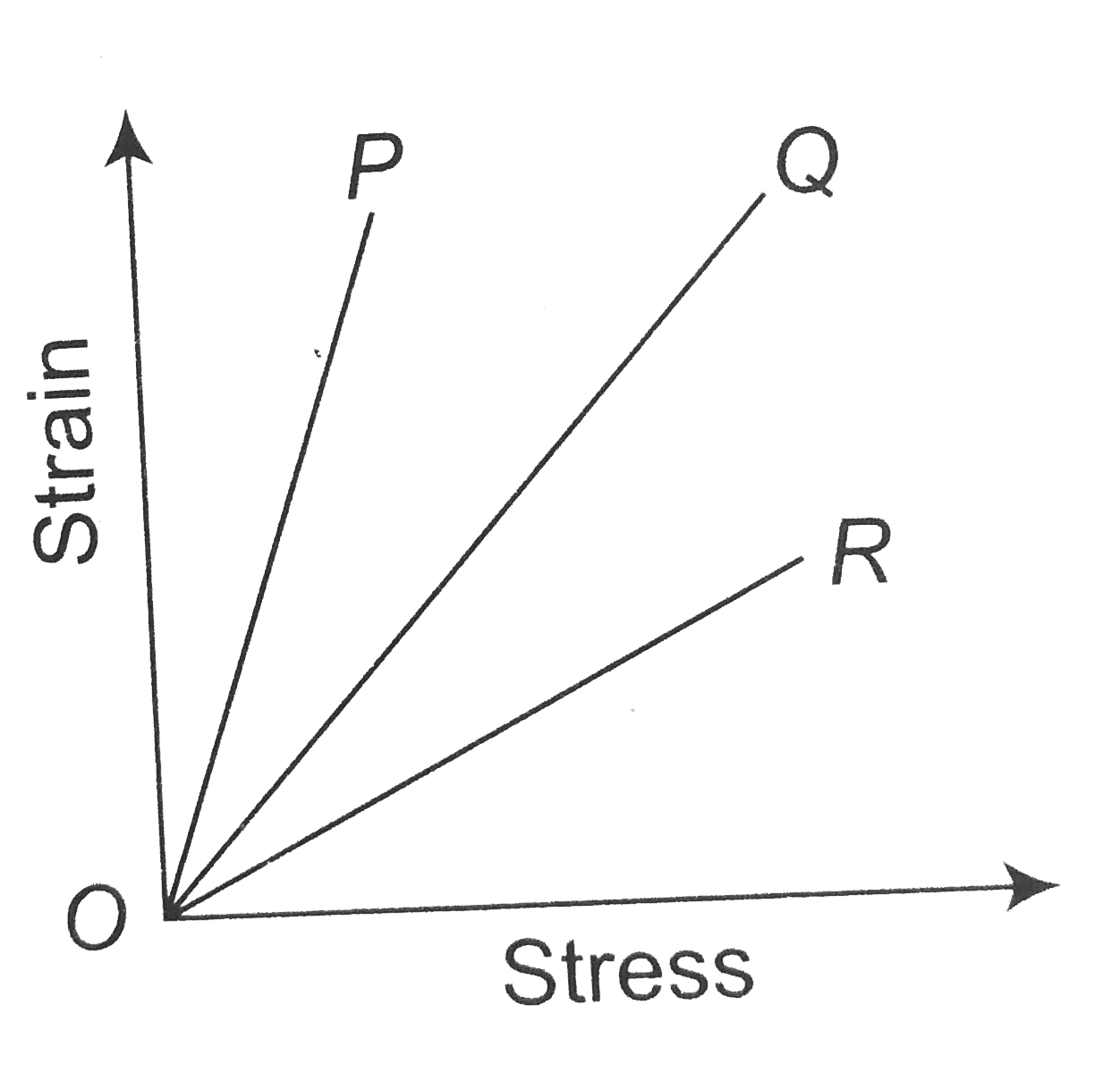
The strain stress curves of three wires of different materials are shown in the figure. P, Q and R are the elastic limits of the wires. The figure shown that
View Solution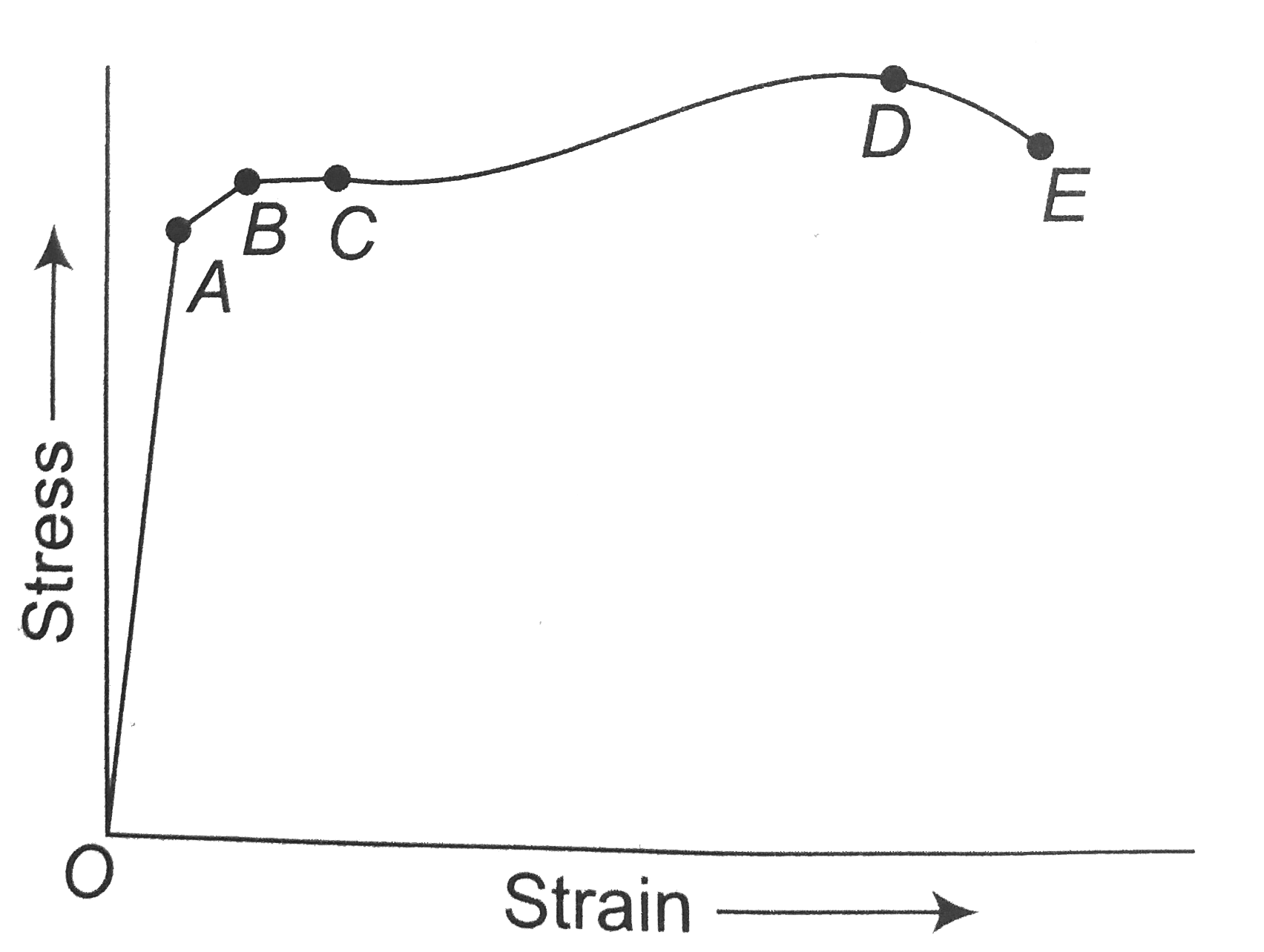
The stress strain graph for a metal wire is as shown in the figure. In the graph, the region in which Hooke's law is obeyed, the ultimate strength and fracture are represented by
View Solution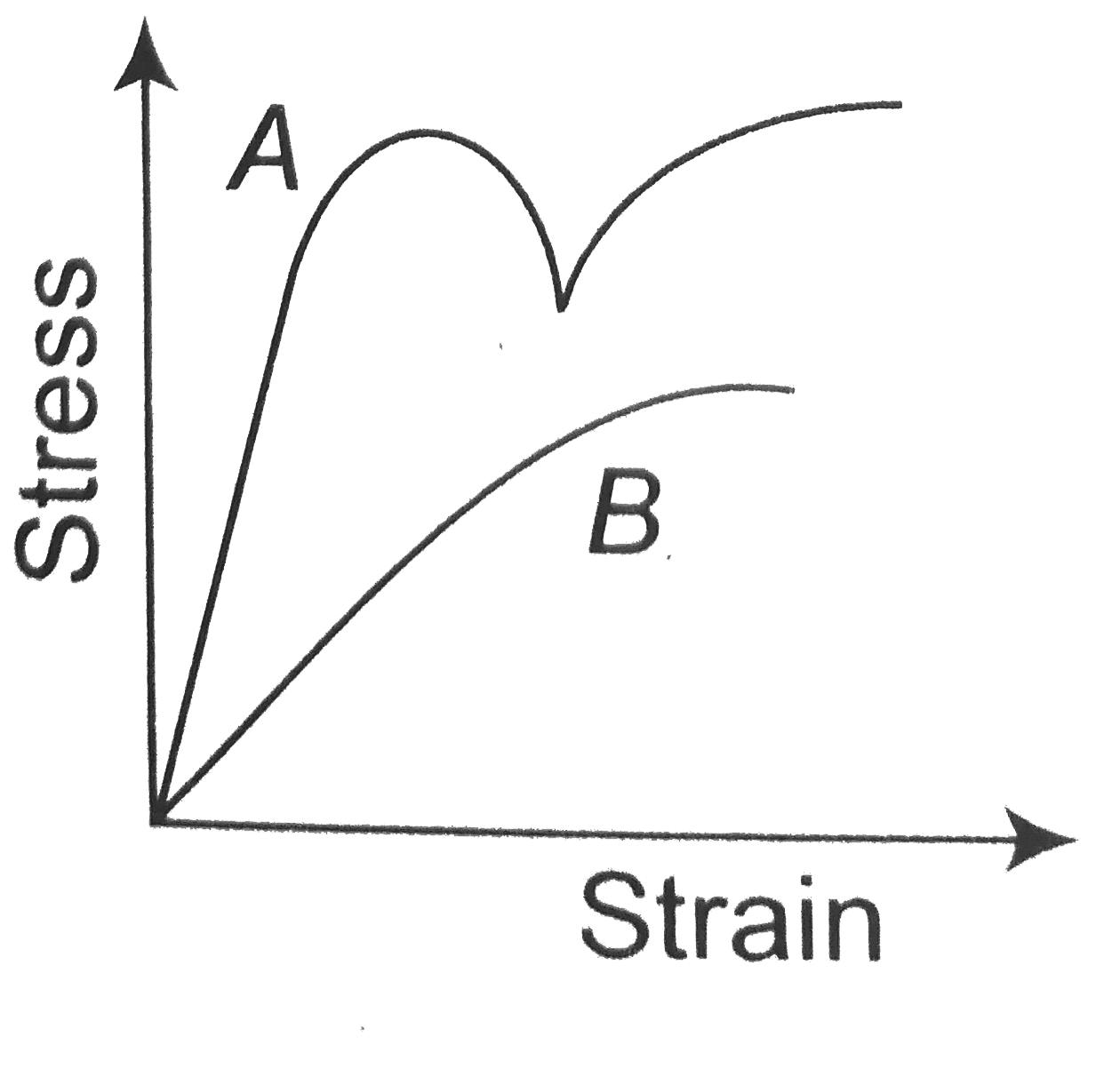
The diagram shoes stress v/s strain curve for the materials A and B. From the curves we infer that
View Solution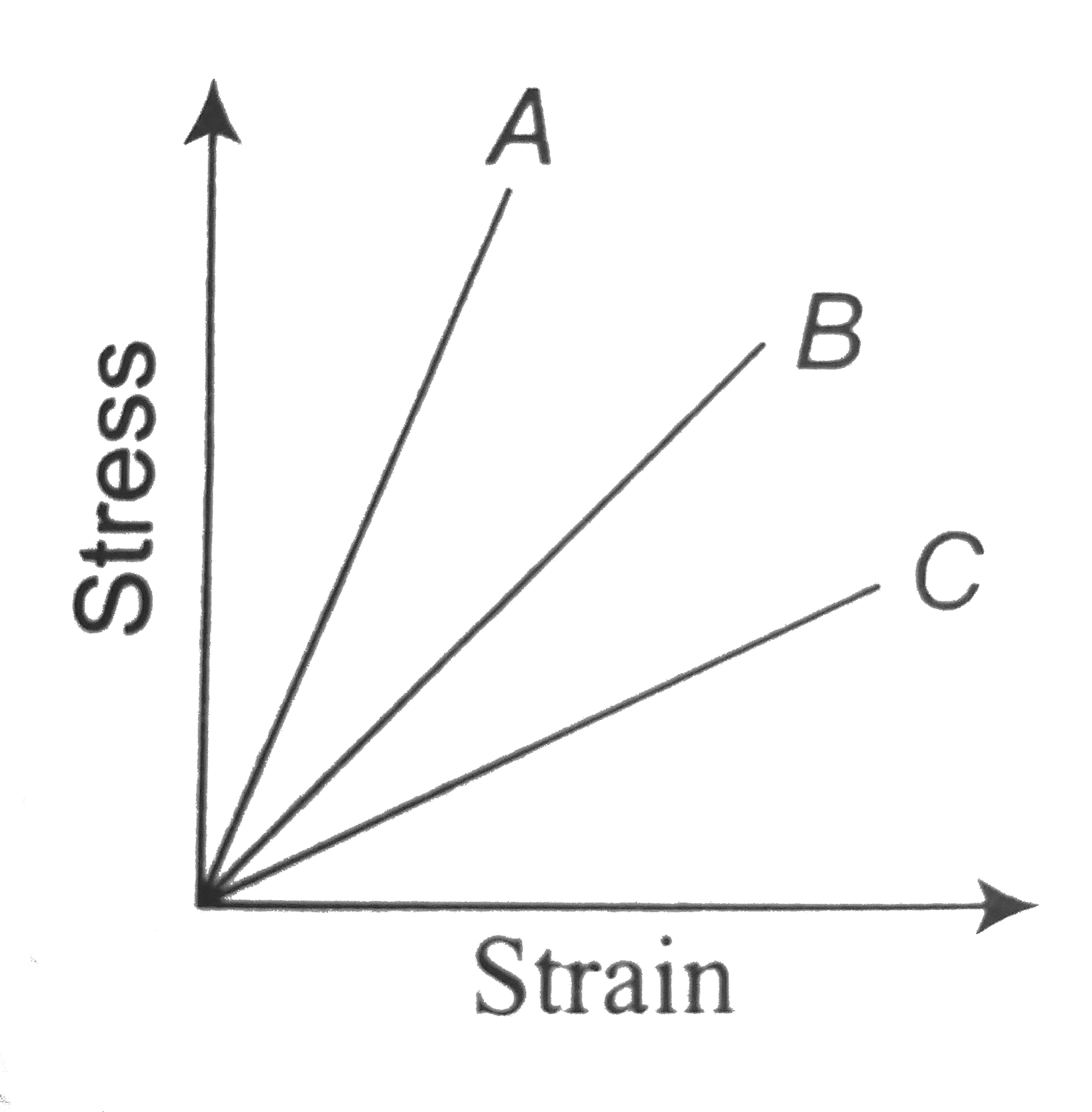
The stress strain curves for brass, steel and rubber are shown in the figure. The lines A, B and C are for
View SolutionFor a perfectly rigid body
View SolutionThree wires P, Q and R of the same material and length have radii 0.1 cm, 0.2 cm and 0.3 cm respectively. Which wire has the highest value of Young's modulus of elasticity?
View Solution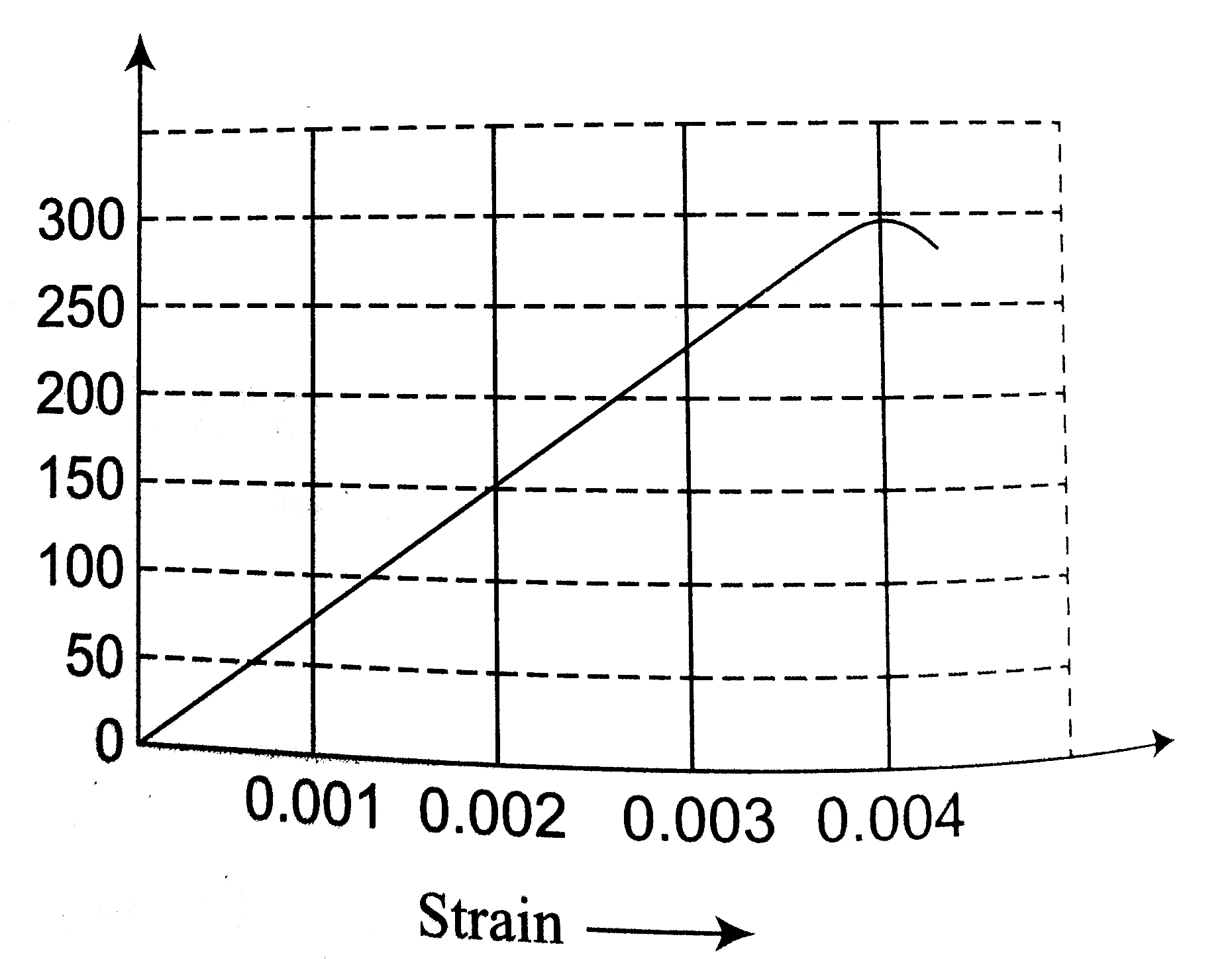
Figure shows the strain stress curve for a given material. The Young's modulus of the material is
View SolutionA steel ring of radius r and cross section area A is fitted on to a wooden disc of radius `R(Rgtr)`. If Young's modulus be E, then the force with which the steel ring is expanded is
View SolutionA substance breaks down under a stress of `10^5` Pa. If the density of the substance is `2xx10^3kg//m^3`, find the minimum length of the wire made of this substance which will break under its own weight `(g=10m//s)`.
View SolutionA force F is needed to break a copper wire having radius R. The force needed to break a copper wire of same length and radius 2R will be
View SolutionA cable that can support a load of 800 N is cut into two equal parts. The maximum load that can be supported by either part is
View SolutionIn steel, the Young's modulus and the strain at the breaking point are `2xx10^11Nm^-2` and 0.15 respectively the stress at the break point for steel is
View SolutionThree wires A,B and C are of the same length and cross section. They are each stretched by applying the same force to the ends. The wire A is stretched least and comes back to its original length when the stretching force is removed. The wire B is stretched more than A and also comes back to its original length when the stretching force is removed. The wire C is stretched most and remains stretched even when stretching force is removed. The greatest Young's modulus of elasticity is possessed by the material of wire
View SolutionOn increasing the length by 0.5 mm in a steel wire of length 2 m and area of cross section 2`mm^2`, the force required is [Y for steel `=2.2xx10^11(N)/(m^2)`]
View SolutionA lift is tied with thick iron and its mass is 314 kg. What should be the minimum diameter of wire if the maximum acceleration of lift is `1.2(m)/(sec^2)` and the maximum safe stress of the wire is `1xx10^7(N)/(m^2)`?
View Solution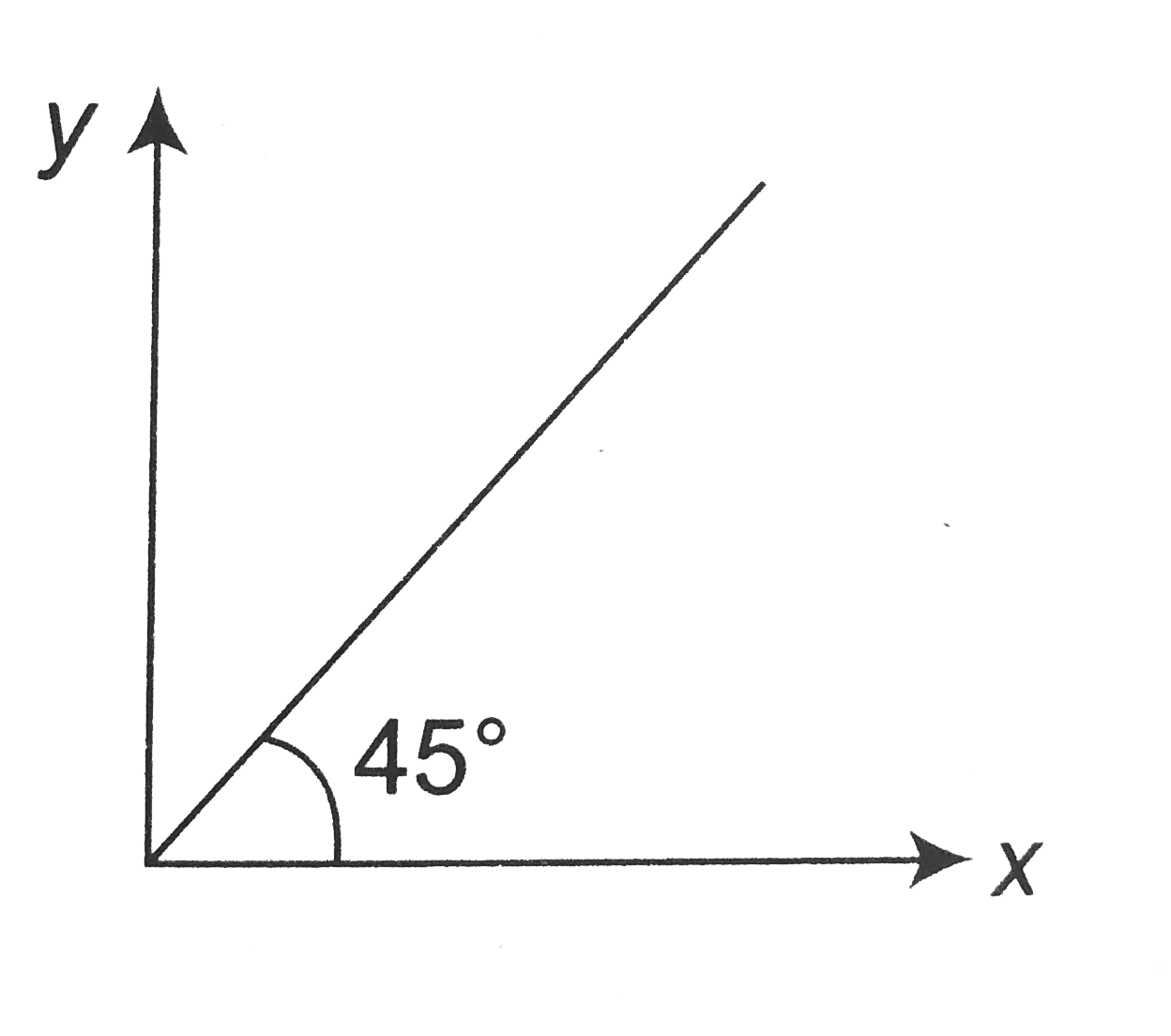
The product of Young's modulus of the material of the wire with its cross sectional area is equal to its length. Find the parameters representing x and y axes of the curve as shown:
View SolutionYoung's modulus of a rod is `(AgL^2)/(2l)` for which elongation is `lamda` due to its own weight when suspended from the ceiling. L is the length of the rod and A is constant, which is:
View SolutionA wire of length L and density `rho` and Young's modulus Y is hanging from a support. Find the elongation in the length of wire at which wire will break:
View SolutionThe wires of same length and Young's modulus are subjected to same tensile force. If `triangleI` is the change in length of wire, and c is the circumference of the wire, find the correct graph. The experiment is performed on the wires of different circumference:
View SolutionA sample of a liquid has an initial volume of 1.5 L The volume is reduced by 0.2 mL, when the pressure increases by 140 kPa. What is the bulk modulus of the liquid?
View SolutionA 900 kg elevator hangs by a steel cable for which the allowable stress is `1.15xx10^8(N)/(m^2)`. What is the minimum diameter required if the elecator accelerates upward at `1.5(m)/(s^2)`? Take `g=10(m)/(s^2)`.
View SolutionFour uniform wires of the same material are stretched by the same force. The dimensions of wire are as given below. The one which has the minimum elongation has:
View Solution
A uniform elastic rod of cross section area A natural length L and Young's modulus Y is placed on a smooth horizontal surface. Now two horizontal forces (of magnitude F and 3F) directed along the length of rod and in opposite direction act at two of its ends as shown . After the rod has acquired steady state, the extension of the rod will be
View Solution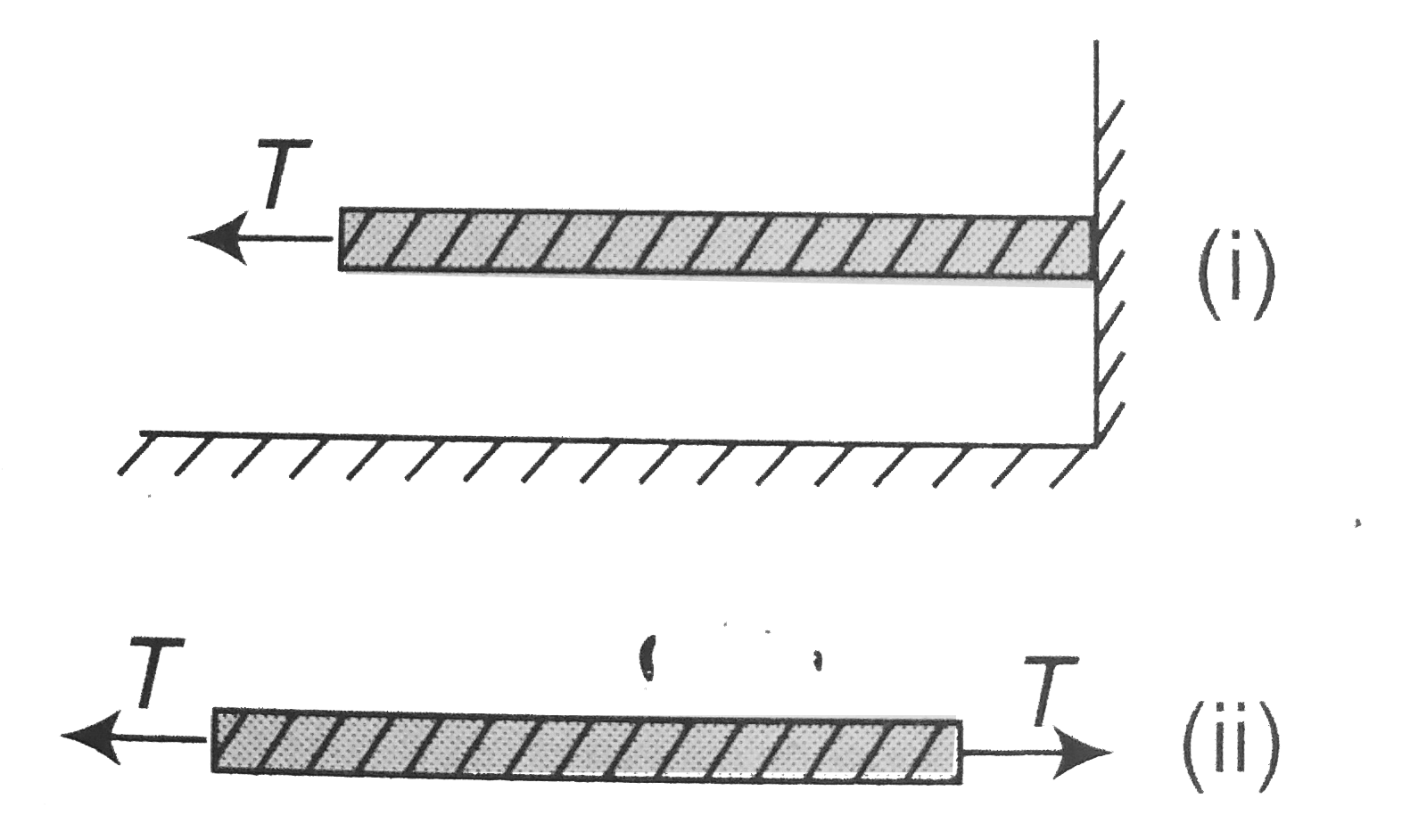
In the figure (i) an extensible string is fixed at one end and the other end is pulled by a tension T. In figure (ii) another identical string is pulled by tension `T'` at both the ends. The ratio of elongation in equilibrium of string in (i) to the elongation of string in (ii) is
View SolutionThe following four wires are made of the same material. Which of these will have the largest extension when the same tension is applied
View SolutionTwo wires shown in figure are made of the same material which has a breaking stress of `8xx10^(8) N/m^(2)`. The area of cross- section of the upper wire is `0.006 cm^(2)` and that of the lower wire is `0.003 cm^(2)`. The mass `m_(1) = 10 kg, m_(2) = 20 kg ` and the hanger is light . Find the maximum load that can be put on the hanger without breaking a wire. Which wire will break first if the load is increased ? ( Take `g = 10 m//s^(2))`
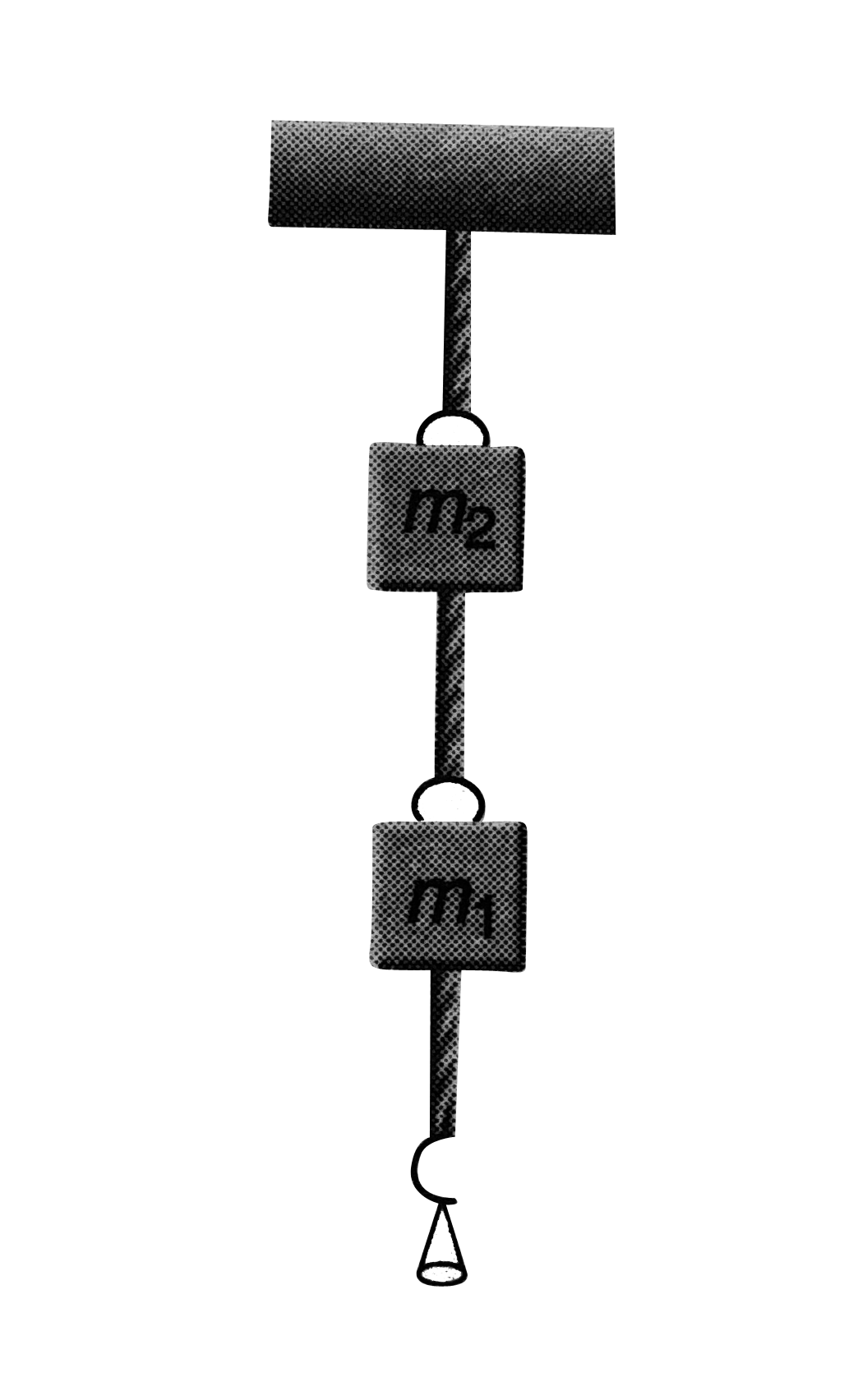
View SolutionTwo wires of diameter `0.25 cm`, one made of steel and other made of brass, are loaded as shown in the figure. The unloaded length of the steel wire is `1.5 m` and that of brass is `1.0 m`. Young's modulus of steel is `2.0 xx 10^(11)`Pa and that of brass is `1.0 xx 10^(11)` Pa. Compute the ratio of elongations of steel and brass wires. `(/_\l_("steel"))/(/_\l_("brass"))=?`
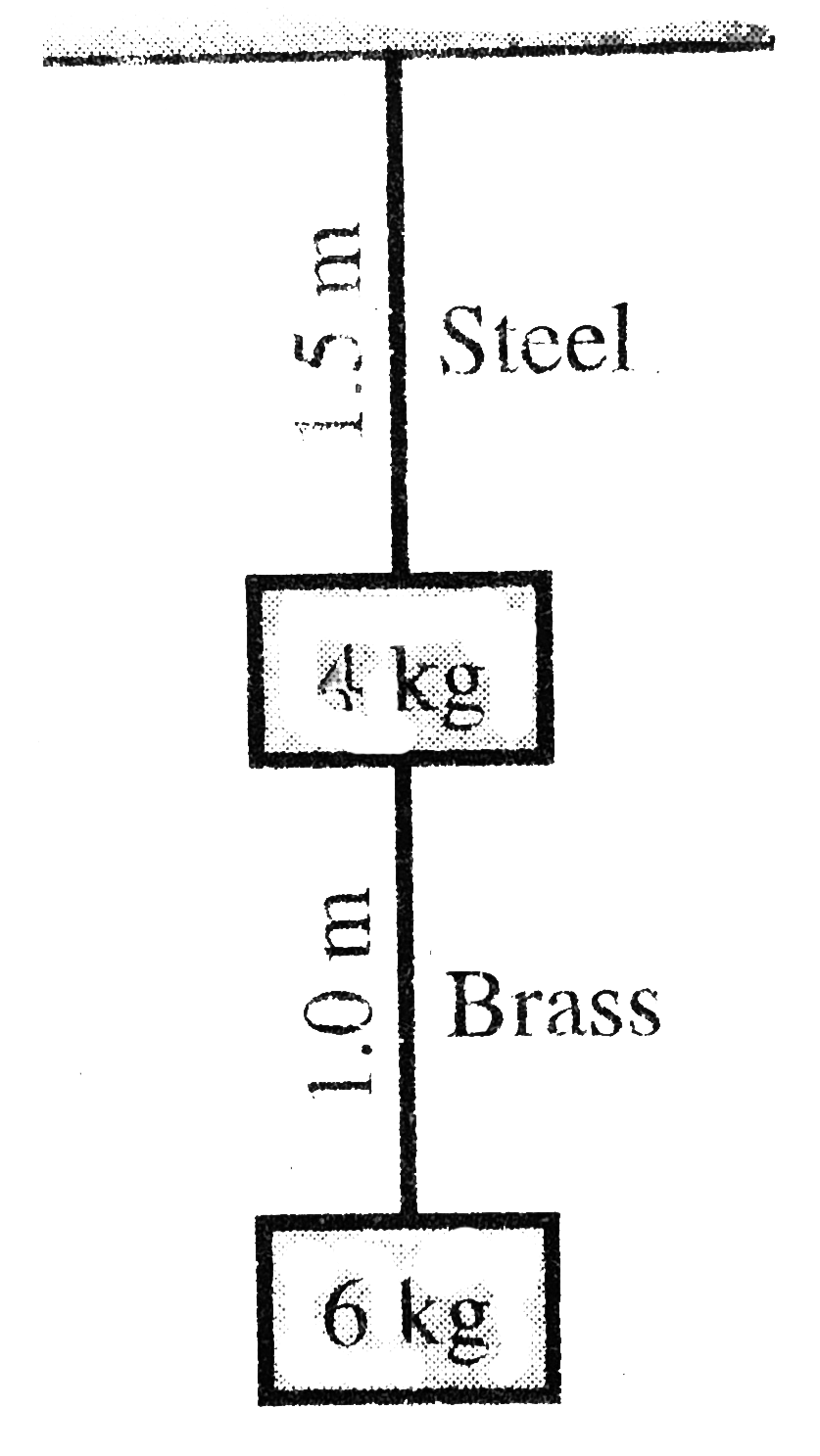
View SolutionWhich of the following statements is correct regarding poissen's ratio?
View SolutionIf the volume of a wire remains constant when subjected to tensile stress, the value of poisson's ratio of material of the wire is
View Solution
Stress, Strain And Young'S Modulus Of Elasticity questions and complete solutions for chapter PROPERTIES OF MATTER of A2Z PHYSICS (HINGLISH) of Class 11